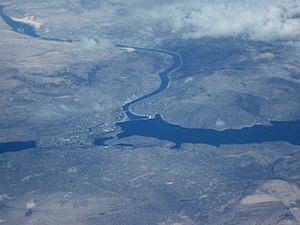Franklin D. Roosevelt Lake facts for kids
Quick facts for kids Franklin D. Roosevelt Lake |
|
|---|---|
| Lake Roosevelt | |

Gifford Ferry crossing Lake Roosevelt near Inchelium; James Stripes photo
|
|
| Location | Washington, US |
| Coordinates | 47°57′22″N 118°58′50″W / 47.95611°N 118.98056°W at Grand Coulee Dam |
| Lake type | reservoir |
| Primary inflows | |
| Primary outflows | Columbia River |
| Basin countries | United States |
| Surface area | 125 sq mi (320 km2) |
Franklin D. Roosevelt Lake (also known as Lake Roosevelt) is a large reservoir in Washington state. It was created in 1941 when the Grand Coulee Dam was built across the Columbia River. The lake is named after Franklin D. Roosevelt, who was the president when the dam was being built.
Lake Roosevelt covers about 125 square miles (320 km²) and stretches for about 150 miles (240 km) from the Canada–US border down to the Grand Coulee Dam. It has over 600 miles (970 km) of shoreline. This makes it the largest lake and reservoir in Washington by surface area. It is also home to the Lake Roosevelt National Recreation Area, a popular spot for outdoor activities.
The reservoir is located in parts of five counties in northeastern Washington. These counties are Ferry, Stevens, Lincoln, Okanogan, and Grant counties.
Contents
Why Was Lake Roosevelt Renamed?
When the lake first formed behind the Grand Coulee Dam, it had different names. The Bureau of Reclamation called it the Columbia Reservoir. Local newspapers in Stevens County often referred to it as Empire Lake.
On April 17, 1945, just five days after President Roosevelt passed away, Secretary of the Interior Harold L. Ickes officially renamed the reservoir Franklin D. Roosevelt Lake. This renaming was a way to honor President Roosevelt. He had strongly supported the dam's construction and helped pass the laws needed to create it.
Who Manages Lake Roosevelt?
Lake Roosevelt and the lands around it are managed by several different groups. They work together under an agreement made in 1990. Their goal is to make sure the lake is used for important purposes like controlling floods, helping boats navigate, and generating electricity.
The National Park Service manages the Lake Roosevelt National Recreation Area. They run visitor centers, provide campsites for boats, and offer shoreline camping. They also have marine patrols to make sure everyone follows boating safety rules.
The Bureau of Reclamation also manages specific areas, especially near the Grand Coulee Dam. They have a facility that collects logs and other large debris before it can float into Lake Roosevelt. This helps keep the lake clear and safe.
Other groups involved in managing the lake include the Bureau of Indian Affairs and the Washington Department of Natural Resources.
Keeping Lake Roosevelt Clean
Lake Roosevelt is located downstream from a large industrial plant in British Columbia, Canada, called the Trail Smelter. This plant used to release waste materials, called slag, into the Columbia River. These materials then flowed into Lake Roosevelt.
People became concerned when these deposits were found to contain metals like mercury, lead, and zinc. The Colville Confederated Tribes, an indigenous group living nearby, were especially worried. They use the lake's beaches and campsites, and they fish in the lake for food and for cultural reasons. The pollution raised health concerns for their community.
In 2004, the Colville Confederated Tribes took action to address the pollution. They wanted the company, Cominco, to help pay for studies to understand the pollution and for cleanup efforts. In 2003, Cominco agreed to invest money for studies on the health of Lake Roosevelt and its environment. They also agreed to fund cleanup work to remove metal contamination linked to their past operations.
Since 1994, Cominco has stopped putting smelting byproducts directly into the Columbia River. The company has also invested a lot of money to update its plant and reduce its emissions. These efforts help protect the environment and keep Lake Roosevelt cleaner for everyone.
See also
 In Spanish: Lago Franklin D. Roosevelt para niños
In Spanish: Lago Franklin D. Roosevelt para niños




